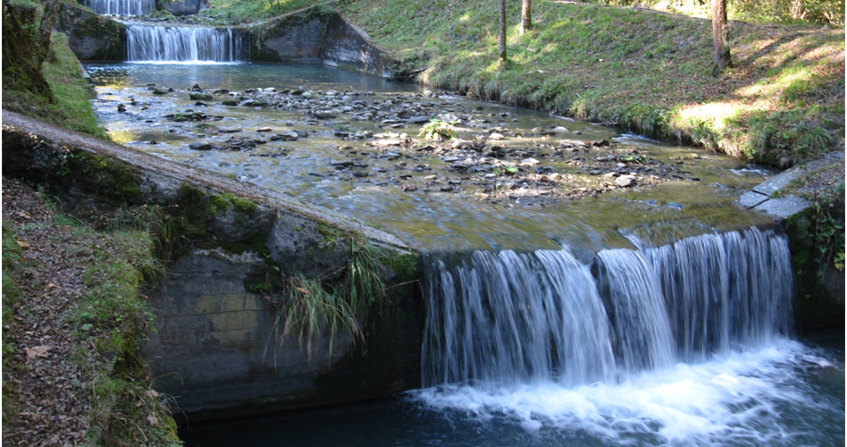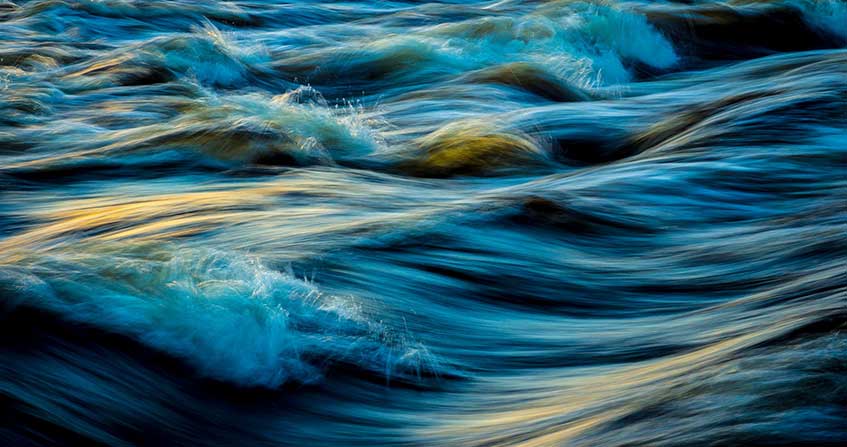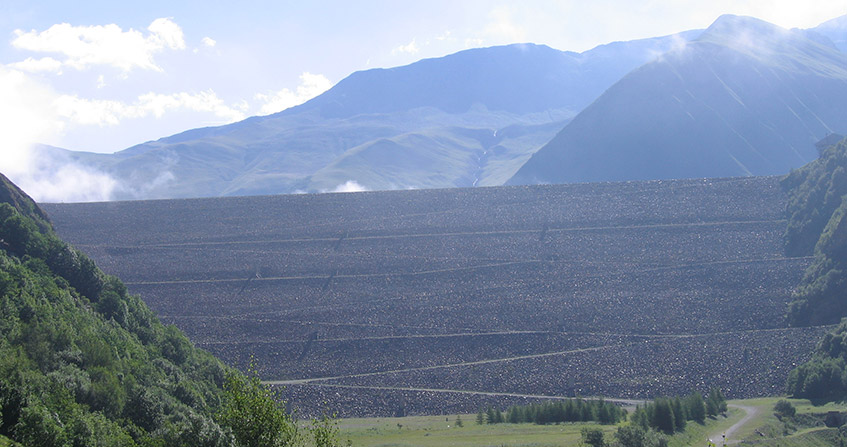How to reconcile dams and sediment transport?
PDF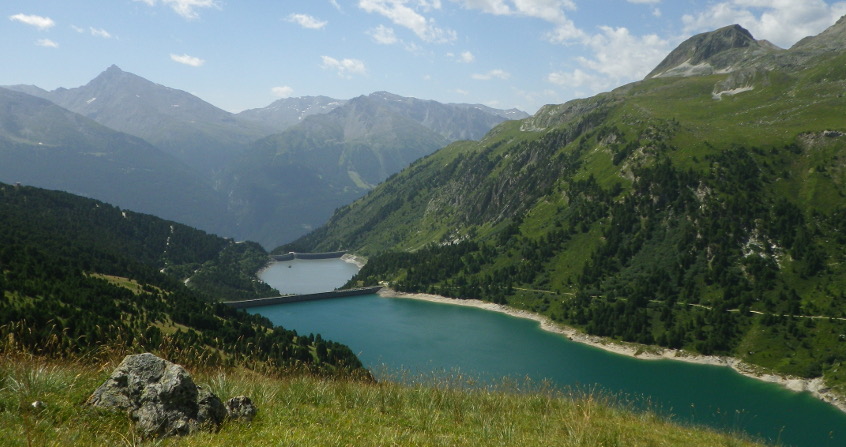
True technical feats, dams have a variety of functions. Thanks to hydroelectricity, they are at the forefront of our renewable energy resources. Their reservoirs allow flood control, support for low water levels, irrigation and the development of recreational facilities. But through sediment capture, they can significantly alter the watercourse regime, the fertility of downstream soils and associated ecosystems, and ultimately the shape of our coasts. What are the main challenges facing their designers to limit these effects?
1. Location and usefulness of dams
1.1. Dams on a global scale: some figures
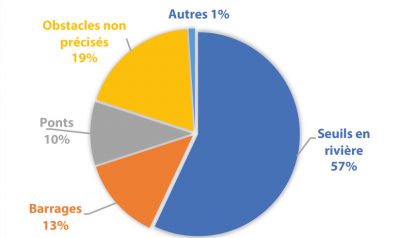
Globally, 48% of rivers are currently regulated and/or fragmented [4]. After a relative stagnation in construction over the past 20 years, there has been an unprecedented increase in the number of projects or constructions of this type of structure in recent years [5]. If the current rate of construction is maintained, 93% of rivers will be regulated and/or fragmented by 20304.
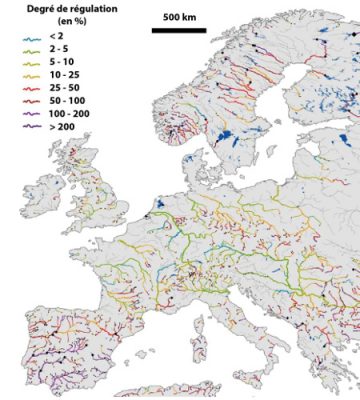
Moreover, the location of these dams does not have the same impact on the degree of regulation [7] of watercourses [8] (Figure 2). The higher the degree of regulation, the more the watercourse is modified in its natural functioning (e. g. residence time of the water).
The distribution of these structures is very uneven across the French territory; it can be noted that the upstream part of the Loire basin, the Dordogne, the Rhône and the alpine reliefs are among the most developed.
1.2. The role of dams
There are several types of dam constructions:
- flexible structures such as the backfill dam (same specificities as the gravity dam)
- rigid structures such as the gravity dam (it rests on the ground; its weight alone is sufficient to contain the thrust exerted by the water in the reservoir; Figure 3), the arch dam (arched, the thrust of the water is transferred to the sides of the valley and the banks), the buttress dam (large concrete wall that relies on buttresses and pushes the pressure of the water towards the ground).
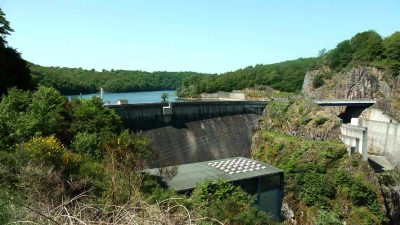
Built in 1675 to supply the Canal du midi [9], the 30 m high Saint-Ferréol dam was the first major French dam. Such structures have been built for various purposes:
- to supply water to industrial activities, in particular mining and metallurgical activities – which are highly water-intensive, particularly in mid-19th century France;
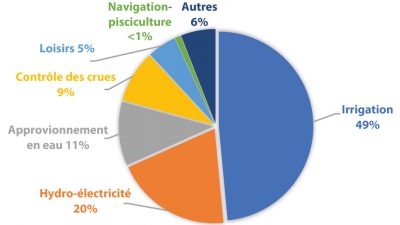
Figure 4. Distribution of unique uses of dams worldwide to supply water to industrial activities, in particular mining and metallurgical activities – which are highly water-intensive, particularly in mid-19th century France. [© ICGB, from http://www.icold-cigb.net/FR/registre_des_barrages/synthese_generale.asp] - for the supply of drinking water;
- for irrigation;
- for electricity production (mainly from the 20th century);
- raising low-water flows and regulating floods; for these purposes, the Seine, for example, has reservoir dams called the “Great Lakes of the Seine” following the major floods at the beginning of the 20th century;
- for inland navigation.
Almost half of the dams have a single purpose. The others have a more or less versatile use. Thus, some dams nowadays often have a recreational purpose (recreational bases) (Figure 4).
2. How do dams affect sediment continuity?
The processes that cause sediments and their fate are erosion, transport, deposition and compaction. The installation of dams on rivers is always accompanied by hydromorphological and physico-chemical modifications, disrupting in particular sedimentary but also ecological continuity. These structures will modify the hydrological regime of the rivers concerned, moving from fluvial dynamic regimes (with current-related turbulence) to static regimes close to lake domains (calmer regimes, less turbulence). This regime modification allows the privileged accumulation of fine particles near the dam while the coarser ones will be more abundant at the tail end of the dam (Figure 5).
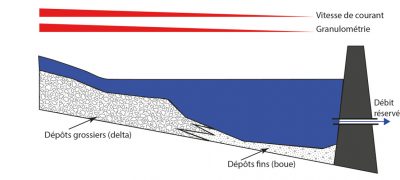
On the other hand, the loss of fine sediments also trapped within dam reservoirs will have negative effects, for example on the downstream transport of nutrients. It can also reduce turbidity in watercourses, which is essential for some fish species to hide from predators. They no longer allow floods to bring fertile silts to agricultural soils downstream (e.g. the Aswan Dam on the Nile in Egypt [12]).
However, the percentage of sediment trapped will depend on the residence time of the water body in the dam. Dam reservoirs are thus fed by the erosion products of the watersheds in which they are built. This sedimentary material can supply dam reservoirs to a greater or lesser extent depending on the lithology (the geological nature of the rocks). It is clear that the material mobilized will not be in the same form or quantity depending on whether one considers a carbonate watershed or a watershed dominated by crystalline rocks such as granites. Similarly, the development of the watershed will play a fundamental role in the nature and abundance of sediments. Indeed, the material contribution resulting from the erosion of geological formations depends on the predominance of forests, agriculture, industrial activities and urbanization.
However, not all dams have the same impact on watercourses. This depends in particular on the height of the structure, its location – more or less upstream of the catchment area, the existence of successive dams on the same watercourse. In absolute terms, the establishment of dams has the effect of increasing the erosion of the upstream areas of the catchment basins and thus increasing their sediment load [13]. This is due in particular to changes in the hydrological functioning of the river. However, what we are seeing is a reduction in the amount of sediment downstream, due to its retention within the reservoirs.
However, this solid load is absolutely necessary in watercourses downstream of structures to maintain their morphological and ecological characteristics. In general, the establishment of dams is therefore inexorably accompanied by a change in the morphology of river banks, deltas, estuaries and coasts due to the impoverishment of sedimentary material. The result is ultimately greater coastal erosion.
3. What to do with the sedimentary material accumulated over time?
The management of dam impoundments does not only concern the structure itself. Indeed, the management of sedimentary material, which is stored or which can transit within and through the structure, is a fundamental issue. Nevertheless, during design, the life of a dam is estimated from the sedimentation rates and volume of an optimal basin. However, the size of the structures is often underestimated in relation to a realistic lifespan. The accumulation of sedimentary material can therefore have a long-term impact:
- the operating efficiency of a hydroelectric dam by affecting its storage capacity;
- influence water resource management;
- weaken or accelerate the ageing of a structure, thus affecting its safety; for example, the Chambon dam in the Alps, built on the Romanche river, whose filling threatened that a risk of rupture would not occur and which was the subject of reinforcement work from 2013 onwards;
- influence its role as a flood regulator (capping);
- and finally, to permanently reduce the quantity and granulometric quality of sediment in watercourses in its downstream part.
The amount of material accumulated can reach several thousands m3 with often much higher sedimentation rates than in natural lake regimes of identical size.
Sediment stock management is generally carried out by punctual and more or less total evacuation, due to the costs or environmental impacts associated with these practices. Management can therefore be achieved through different approaches:
- those that limit sediment input upstream of the dam;
- those that remove by cleaning, for example, sediments already accumulated;
- and those that allow sediments to pass through the dam at specific times, or to bypass them (see Focus).
To address these problems, solutions are being implemented or considered for (future) construction. Among these, the choice of the location of a dam itself is essential. It must be built more or less upstream of the catchment area, taking into account the erosion propensity of the chosen site, the solid load involved, the hydromorphological characteristics of the river to be developed… Other solutions can also be considered such as the installation of bypass systems or turbines accepting the passage of more or less fine sediments.
Sediment filling of the reservoir over time therefore requires special management, which can be problematic depending on the quality of the sediment. Indeed, since the dam has played a role in hyperaccumulating contamination, large volumes of highly contaminated sediments cannot be discharged by flushing into the natural environment under penalty of pollution downstream of the watercourse.
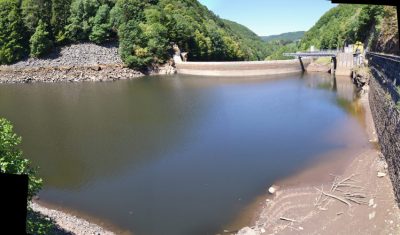
Naturally, the geochemical bottom of a watershed in which a dam is located may be higher than national averages (e.g. presence of mineralized veins). This disturbance, natural or otherwise, of sediment quality mainly concerns inorganic contaminants. These elements are usually metals or metalloids usually present in low concentrations (or traces). They can be potentially toxic to the environment depending on the form (speciation and mineralogy) in which they are present. These are most often the following elements: As, Cd, Cr, Cu, Hg, Ni, Pb, Sb and Zn.
Their presence in exceptional concentrations is most often associated with human activities at the watershed level. Thus, mining activities exploiting these elements will affect the quality of sediments in nearby watercourses (as observed in the Villerest dam, Loire basin in its upstream part [14]). Indeed, the exploitation of this natural resource will make some elements that have been stable within the rocks more accessible/mobile. Disruptions related to excavation and crushing (reduction in particle size) of the extracted rocks will modify the physico-chemical parameters of the environment and promote oxidation and hydrolysis reactions of the mineral phases, for the main ones. These elements are then “redistributed” within the sediments and feed the reservoir of a possible dam. The sediments then contain elements in more mobile and reactive forms than they were at the beginning.
This contamination can also be of an organic nature: we speak of persistent organic pollutants (POPs). Their origin can be natural (forest fires, volcanic eruptions…) or anthropogenic. Discharges from certain industrial processes or from agricultural activity – PAHs (polycyclic aromatic hydrocarbons), PCBs (polychlorinated biphenyls), pesticides (organochlorines) – have a significant impact on sediments. For example, 20 reservoirs in the Italian Central Alps have shown PCB contamination [15]. Domestic effluents, as well as agricultural activities, are also responsible for the release of phosphorus (P), a factor that favours the eutrophication of dam reservoirs. In summer, this phenomenon can lead to excessive blooms of cyanobacteria producing toxins (cyanotoxins). The reservoirs are then unsuitable for swimming (read Phosphorus and Eutrophication)
The management of contaminated sediment stocks is delicate or even impossible within dam reservoirs. This can lead to the stopping of the dam’s activity, or even its destruction, allowing the watercourse to recover its original functioning (also called erasure). Nevertheless, the attractive scenarios of dam removal to restore sedimentary and ecological continuity of a watercourse seem difficult to achieve in the case of large dams. Such a synopsis does not, however, prevent us from having to deal, at some point, with the management of sediments -contaminated or not- accumulated over the years.
5. Messages to remember
- A resurgence in the construction of large dams is expected by 2030; their usefulness is undeniable for electricity production and energy storage, flood and drought regulation, irrigation…
- However, they constitute physical barriers that modify in particular the hydrological regime, the physico-chemical characteristics and the solid load of the watercourses concerned.
- Solutions exist to restore the transit of sediments from time to time, but…
- Sediment management in these artificial reservoirs can be difficult since, during their deposition, due to their long residence time, they can accumulate organic and inorganic pollutants.
References and notes
Cover image. Upstream Plan and Downstream Plan dams, Haute Maurienne Valley. [Source: © Photo A. Courtin-Nomade.]
[1] McCully, P., (2001). Silenced rivers: the ecology and politics of large dams. Zed Books Publisher
[2] Friedl, G. & Wüest, A. (2002). Disrupting biogeochemical cycles – Consequences of damming. Aquatic Sciences, 64, 55-65.
[3] Dam more than 15 m high above the foundation level or between 5 and 15 m high and with a capacity greater than 3 Mm3. http://www.icold-cigb.net/home.asp, January 2018
[4] Grill, G., Lehner, B., Lumsdon, A.E., MacDonald, G.K., Zarfl, C., Lierman,n, C.R. (2015). An index-based framework for assessing patterns and trends in river fragmentation and flow regulation by global dams at multiple scales. Environmental Research Letters, 10, 1-15.
[5] Zarfl, C., Lumsdon, A.E., Berlekamp, J., Tydecks, L., Tockner, K., (2015). A global boom in hydropower dam construction. Aquatic Sciences, 77, 161-170
[6] Fixed or movable structures that block only the minor bed of the river – partially or totally – in contrast to the dam that blocks more than the minor bed.
[7] The degree of regulation makes it possible to account for changes that may affect the regime of a watercourse (e.g., flow), particularly its residence time. A high degree of regulation indicates a high probability that a significant volume of water will be temporarily stored in a given year and then released. Temporal storage and later release of water bodies will alter the natural regime of the river and, due to the stagnation and stratification of water bodies within the reservoir, affect other parameters such as temperature, dissolved oxygen concentration or solid load (suspended solids). Thus, reservoirs that have storage capacities for water bodies of several years and whose operation is governed solely by water demand (e.g., low water level rise, flood regulation) have regulation degrees >100%.
[8] Lehner, B., Liermann, C. R., Revenga, C., Vörösmarty, C., Fekete, B., Crouzet, P., Döll, P., Endejan, M., Frenken, K., Magome, J., Nilsson, C., Robertson, J. C., Rödel, R., Sindorf, N., Wisser, D., (2011). High-resolution mapping of the world’s reservoirs and dams for sustainable river-flow management. Frontiers in Ecology and Environment, 9, 494-502.
[9] Bordes, J.L., (2006). Les barrages du XVIIe siècle à la fin du XIXe, transferts technologiques et modes d’élaboration des ouvrages, in Les Archives de l’invention, colloque des 26-27 mai 2003, Conservatoire national des Arts et Métiers, Toulouse, CNRS/Université de Toulouse-Le Mirail, 227-240
[10] Vörösmarty, C.J., M., M., Fekete, B., Sharma, K., Green, P. & Syvitski, J.P. (2003) Anthropogenic sediment retention: major global impact from registered river impoundments. Global and Planetary Change, 39, 169-190
[11] Toniolo, H., Schultz, J. (2005). Experiments on sediment trap efficiency in reservoirs. Lakes & Reservoirs: Research and Management, 10, 13-24
[12] Pacini, N., Donabaum, K., De Villeneuve, P.H., Konecny, C., Pineschi, G., Pochon, Y., Salerno, F., Schwaiger, K., Tartari, G., Wolfram, G., Zieritz, I. (2013). Water quality management in a vulnerable large river: the Nile in Egypt. International Journal of River Basin Management, 11, 205-219.
[13] Van Maren, D.S., Yang, S.-L., He, Q. (2013). The impact of silt trapping in large reservoirs on downstream morphology: the Yangtze River. Ocean dynamics, 63, 691-707.
[14] Dhivert, E., Grosbois, C., Coynel, A., Lefèvre, I., Desmet, M. (2015). Influences of major flood sediment inputs on sedimentary and geochemical signals archived in a reservoir core (Upper Loire Basin, France). Catena, 126, 75-85
[15] Laura, M., Tartari, G., Salerno, F., Valsecchi, L., Bravi, C., Lorenzi, E., Genoni, P., Guzzella, L. (2017). Climate Change Impacts on Sediment Quality of Subalpine Reservoirs: Implications on Management. Water, 9, 680.
The Encyclopedia of the Environment by the Association des Encyclopédies de l'Environnement et de l'Énergie (www.a3e.fr), contractually linked to the University of Grenoble Alpes and Grenoble INP, and sponsored by the French Academy of Sciences.
To cite this article: COURTIN-NOMADE Alexandra (February 7, 2019), How to reconcile dams and sediment transport?, Encyclopedia of the Environment, Accessed April 26, 2024 [online ISSN 2555-0950] url : https://www.encyclopedie-environnement.org/en/water/how-reconcile-dams-sediment-transport/.
The articles in the Encyclopedia of the Environment are made available under the terms of the Creative Commons BY-NC-SA license, which authorizes reproduction subject to: citing the source, not making commercial use of them, sharing identical initial conditions, reproducing at each reuse or distribution the mention of this Creative Commons BY-NC-SA license.





